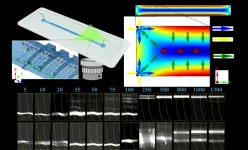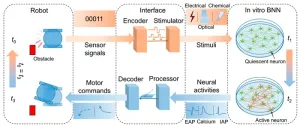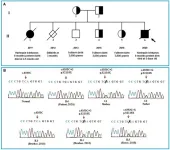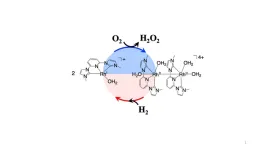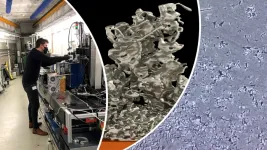(Press-News.org) A research paper by scientists at the Hebei University of Technology and Shenzhen University developed an on-chip viscoelasticity sensor for biological fluids.
The new research paper, published on Jan. 10, 2023 in the journal Cyborg and Bionic Systems, reported a double-layered microfluidic sensor to detect the ultra-weak viscoelasticity in biological fluids.
“Most of human body fluids are non-Newtonian liquids, and the influence of viscoelasticity is often ignored for the sake of simplification of analysis. However, we found that even a very weak change in viscoelasticity can affect the trajectory of micro-particles inside the liquid. Therefore, this viscoelastic effect cannot be ignored in many situations that require elaborate analysis. For this reason, we developed this viscoelastic sensor to detect the weak viscoelastic changes of non-Newtonian liquids” explained by the corresponding author Sheng Yan, an assistant professor at the Shenzhen University.
“Our microfluidic device is analogy to a "miniature liquid Galton plate". We “poured” a large amount of microparticles into the channel, recorded the trajectory and distribution of microparticles, and estimate the viscoelasticity of the liquid,” said Dr Yan. Experiments have proved that even for non-Newtonian liquids with weak viscoelasticity, slight changes in their viscoelasticity will cause observable changes in the trajectory and distribution of micro-particles, thus making it possible to detect subtle viscoelastic changes in non-Newtonian liquids.
To estimate the viscoelasticity of the liquid to be measured, the mapping relationship between particle distribution and liquid viscoelasticity must first be established. The process of determining this mapping relationship is called the calibration process of the viscoelastic sensor.
By observing the movement trajectory of microparticles in different viscoelastic liquids, it can be seen that “Similar to changing the nail on the Galton plate, the movement trajectory of the steel ball will be changed,” said Yan, “Changing the viscoelasticity of the liquid will also change the movement trajectory of the microparticles. This shows that it is feasible to measure the viscoelasticity of liquid with this microfluidic chip.”
Finally, the authors also measured the relaxation time of various non-Newtonian liquids (5-500 ppm PEO), and fitted a function to estimate the relaxation time of the liquid to be measured. According to this function, the relaxation time of the liquid to be measured can be quickly determined. For example, the relaxation times of 5 ppm and 10 ppm PEO solutions are 0.45 ms and 0.7 ms respectively, and the viscoelasticity of plasma is closest to that of 5 ppm PEO solution, so the relaxation time is approximately 0.45 ms.
“This viscoelasticity sensor has the great potential for early diagnostics of many severe diseases,” said Yan. Via this on-chip viscoelasticity biosensor, we could detect the changes in blood viscoelasticity, which can be an important indicator for these inflammatory and vascular diseases.
Authors of the paper include Qianbin Zhao, Sheng Yan, Boran Zhang, Kai Fand, Jun Zhang, Weihua Li.
The paper, "An On-Chip Viscoelasticity Sensor for Biological Fluids," was published in the journal Cyborg and Bionic Systems at DOI: https://spj.science.org/doi/10.34133/cbsystems.0006.
Reference
Authors: Qianbin Zhao,1 Sheng Yan,2 Boran Zhang,3 Kai Fan,4 Jun Zhang,5 Weihua Li6
Title of original paper: An On-Chip Viscoelasticity Sensor for Biological Fluids
Journal: Cyborg and Bionic Systems
DOI: 10.34133/cbsystems.0006.
Affiliations:
1Hebei Key Laboratory of Biomaterials and Smart Theranostics, School of Health Sciences and Biomedical Engineering, Hebei University of Technology, Tianjin 300131, China
2Institute for Advanced Study, Shenzhen University, Shenzhen 518060, China
3School of Electrical and Electronic Engineering, Nanyang Technological University, Singapore 639798, Singapore
4Department of Precision Machinery and Precision Instrumentation, University of Science and Technology of China, Hefei 230026, China
5Queensland Micro and Nanotechnology Centre, Griffith University, Brisbane, QLD 4111, Australia
6School of Mechanical, Materials, Mechatronic and Biomedical Engineering, University of Wollongong, Wollongong, NSW 2522, Australia
A brief introduction about yourself.
About Dr. Sheng Yan:
Sheng Yan is Assistant Professor at Shenzhen University, Fellow of Japan Society for the Promotion of Science, Shenzhen Peacock Talent Fellow, and Zhujiang Talent Young Fellow. His research interests are lab on a chip, microfabrication, cell separation, imaging flow cytometry, deep learning and nanophotonics. Up to now, he has published over 70 SCI papers in high-impact journals, including Nature Communications, Advanced Functional Materials, Small, Lab on a Chip, Analytical Chemistry, Sensors and Actuators B: Chemical with the h-index of 30 and total citations of over 3200.
Personal Homepage: https://scholar.google.co.jp/citations?user=1jjvS4gAAAAJ&hl=en
END
A review paper by scientists at the Beijing Institute of Technology summarized recent efforts and future potentials in the use of in vitro biological neural networks (BNNs) for the realization of biological intelligence, with a focus on those related to robot intelligence.
The review paper, published on Jan. 10 in the journal Cyborg and Bionic Systems, provided an overview of 1) the underpinnings of intelligence presented in in vitro BNNs, such as memory and learning; 2) how these BNNs can be embodied with robots through bidirectional ...
The American Society for Biochemistry and Molecular Biology today announced its 2023 class of fellows. The honorific program recognizes scientists who have made outstanding contributions to the field through their research, teaching, mentoring or other forms of service.
The society will recognize the 20 new fellows at its annual meeting, Discover BMB, later this month in Seattle. The presentation will be part of the society's presidential address and business meeting scheduled for Saturday, March 25.
“This group truly represents members who have ...
Harlequin ichthyosis (HI) is a severe genetic skin disorder characterized by thick white, brown, or dark brown patches on the skin covering a newborn's entire body. HI has a low incidence of 1 per 300,000 live births but comes with the highest mortality rate among skin conditions. It is caused by a mutation in the ABCA12 gene, which codes for a protein involved in transporting lipids necessary for the formation of the skin barrier. Such protein shortage leads to a weaker epidermal barrier.
A recent study, co-authored by BGI Genomics Dr. Thomas Qiu, published in Frontiers in Pediatrics covers ...
Like poles support a tent, microtubules—hollow cylindrical structures made of tubulin protein—support eukaryotic cells. But microtubules provide more than just mechanical strength; they help prepare the cell for cell division and migration and work as a railway track on which motor proteins transport materials within the cell. The formation of microtubules within cells resembles how a child assembles a Lego train track. The tubulins—Lego bricks—constantly assemble and disassemble to make the microtubule—train track—longer and shorter in processes called polymerization and depolymerization. The processes are regulated by microtubule-associated proteins such ...
SAN FRANCISCO (March 9, 2023) — Researchers at the California Academy of Sciences, along with a collaborator at Denison University, have developed an innovative new model to assess how the California economy might have fared without economic closures to slow the spread of the coronavirus pandemic. Their initial findings—published today in Frontiers in Physics—reveal that under a “business-as-usual” approach wherein there were no business closures, California’s economy would have generally been better off than in reality. However, the economic impacts would still have been substantial and ...
Both conservative and liberal Americans share fake news because they don’t want to be ostracized from their social circles, according to research published by the American Psychological Association.
“Conformity and social pressure are key motivators of the spread of fake news,” said lead researcher Matthew Asher Lawson, PhD, an assistant professor of decision sciences at INSEAD, a business school in France. “If someone in your online tribe is sharing fake news, then you feel pressure to share it as well, even if you don’t ...
Fukuoka, Japan—Hydrogen peroxide is a ubiquitous chemical found in most homes and used in everything from dying hair to treating wounds. It is also an invaluable agent for many industries from food, textiles, and even in semiconductor production.
Reporting in JACS, researchers at Kyushu University have developed a new process to synthesize this chemical utilizing a new homogeneous catalyst inspired by nature. Moreover, the process is significantly safer than conventional methods.
Scientists have been reporting the synthesis ...
A novel type of therapy, known as ANGPTL3 inhibitor therapy, was effective in lowering triglycerides in certain types of patients with severe hypertriglyceridemia (sHTG) who had a prior episode(s) of acute pancreatitis. sHTG is a well-established risk factor for recurrent episodes of acute pancreatitis. These high-risk patients were the focus of a phase 2 study that was led by the Icahn School of Medicine at Mount Sinai and sponsored and funded by Regeneron.
This ANGPTL3 inhibitor therapy, the intravenous drug evicanumab-dgnb, inhibits two important regulators of lipoprotein metabolism. ...
With the advent of the Metaverse era, there have been growing expectations that virtual reality (VR) and augmented reality (AR) technologies will likely to enhance convenience in everyday life, as well as industry productivity performance.
A joint research team, affiliated with UNIST has introduced core technology for smart contact lenses that can implement AR-based navigation through a 3D printing process. According to the research team, the new smart contact lenses can be worn inside the eye of a person, like a normal contact lens.
Published in the February 2023 issue of Advanced Science, this breakthrough has been jointly led by ...
Innovative battery researchers have cracked the code to creating real-time 3D images of the promising but temperamental lithium metal battery as it cycles. A team from Chalmers University of Technology, Sweden, have succeeded in observing how the lithium metal in the cell behaves as it charges and discharges.
The new method may contribute to batteries with higher capacity and increased safety in our future cars and devices.
“We’ve opened a new window in order to understand – and in the long term to optimise – the lithium metal batteries of the future. When we can study exactly what happens to the lithium in ...
